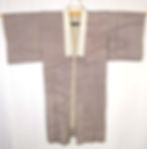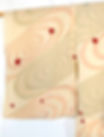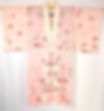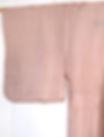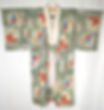Juban
Women's Under Kimono
Juban Kitsuke Accessories:
1 korin belt, 1 datejime, 1 han-eri, 1 eri-shin
Contrary to popular belief, a person is not nude under their kimono. Japanese kimono are commonly worn in layers, with the most common underlayer being a juban. Men also wear a juban under their kimono however their juban are styled slightly differently. The various juban for sale on this page are intended to be worn in a feminine style. Juban are worn under Japanese kimono, with just the collar visible. Juban are worn by all genders and ages in Japan. Juban are typically worn under a kimono with the collar visible. Juban are typically worn with all kimono. Yukata do not commonly have a juban worn under them, though some people prefer to. Due to variations in monitor color settings we can not 100% guarantee the colors of our products. Most goods in our online store are gently used, unless stated as being brand new.
Han-Eri Juban Collars
When wearing a juban under a Japanese kimono, only a hint of the sleeves and the collar are visible. To protect the juban from the natural oils on a person's skin and makeup a han-eri is added to the collar. A han-eri is a decorative piece of fabric that is seen under the kimono collar along the neck. Han-eri are meant to be interchangeable and require no advanced sewing skills to add to a juban. When added they also create a pocket for the eri-shin to be held. Eri-shin are plastic collar stiffeners that give kimono collars their crisp clean look.
Han-Eri For Juban
By adding a single han-eri you can radically influence the appearance and aesthetic of a Japanese kimono. This simple kitsuke accessory is commonly overlooked by people new to dressing in kimono, and are beloved by more experience kimono wearers. They are a fun way to sneak in a wide variety of personal touches into your coordination with designs ranging from popular pop-culture themes to more traditional symbolism. Most of our han-eri in stock are brand new, and ready to be added to a juban. Han-eri normally have unfinished edges, which may be finished or left unfinished by their new owner. Our han-eri are larger than average to allow for finishing if the owner so desires. Finishing han-eri is not needed and does not impact look or presentation. Long term han-eri will get dirty and need to be cleaned by removing them from the juban collar, and after a while many haneri are discarded because they are too dirty to wear anymore, protecting the juban and kimono from such dirt.
Japanese Kimono Are Worn In Layers
There is a misperception that kimono function much like a bathrobe, and that a person does not wear anything under their kimono. In reality, traditional kimono dressings are layered. Juban are a universal kimono accessory worn by all genders and ages. The exception is generally yukata and onsen kimono because they are highly informal, and to be worn when the weather is worn. Even so under garments are still worn under a yukata.





